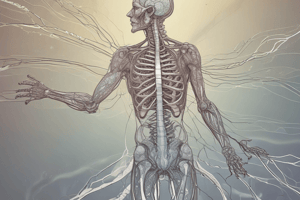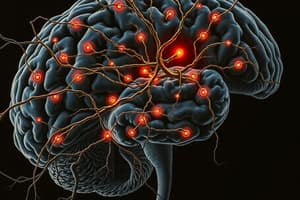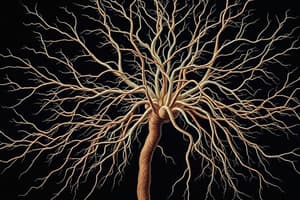Podcast
Questions and Answers
What is the primary function of the somatic nervous system?
What is the primary function of the somatic nervous system?
- Regulating involuntary movements
- Transmitting signals to skeletal muscles (correct)
- Processing sensory information
- Controlling emotional responses
Which part of the hindbrain is responsible for regulating breathing and sleep?
Which part of the hindbrain is responsible for regulating breathing and sleep?
- Pons (correct)
- Cerebellum
- Medulla
- Thalamus
What role does the cerebellum play in human movement?
What role does the cerebellum play in human movement?
- Processes auditory information
- Coordinates voluntary movements and posture (correct)
- Regulates heart rate
- Produces dopamine
Which lobe of the brain is primarily involved in auditory processing and language comprehension?
Which lobe of the brain is primarily involved in auditory processing and language comprehension?
What is one of the main functions of the frontal lobe?
What is one of the main functions of the frontal lobe?
Which part of the midbrain is involved in motor functions and pain perception?
Which part of the midbrain is involved in motor functions and pain perception?
What is the primary role of the hypothalamus in the forebrain?
What is the primary role of the hypothalamus in the forebrain?
Which of the following is NOT a function of the parietal lobe?
Which of the following is NOT a function of the parietal lobe?
What is the primary role of the nervous system?
What is the primary role of the nervous system?
Which component is included in the central nervous system?
Which component is included in the central nervous system?
What function does the spinal cord serve?
What function does the spinal cord serve?
Which division of the peripheral nervous system prepares the body for 'fight or flight' responses?
Which division of the peripheral nervous system prepares the body for 'fight or flight' responses?
How does the peripheral nervous system support sensory functions?
How does the peripheral nervous system support sensory functions?
What is one of the main functions of the brain within the central nervous system?
What is one of the main functions of the brain within the central nervous system?
What is a function attributed to the autonomic nervous system?
What is a function attributed to the autonomic nervous system?
Which part of the nervous system is responsible for homeostasis?
Which part of the nervous system is responsible for homeostasis?
Flashcards are hidden until you start studying
Study Notes
Overview of the Nervous System
- Composed of the brain, spinal cord, and nerves.
- Functions include sending electrical signals throughout the body and regulating physiological processes.
Parts of the Nervous System
- Central Nervous System (CNS): Consists of the brain and spinal cord.
- Peripheral Nervous System (PNS): Comprises nerve cells that relay information to and from the CNS.
Central Nervous System Functions
- Processing Information: Handles sensory data, thoughts, emotions, and decision-making.
- Control Center: Regulates both voluntary and involuntary bodily activities.
- Coordination: Manages muscle movements and complex behaviors.
- Reflex Actions: The spinal cord mediates quick reflexes without brain involvement.
- Homeostasis Maintenance: Regulates key functions like temperature, hunger, and sleep.
Peripheral Nervous System Functions
- Signal Transmission: Connects the CNS with the body.
- Sensory Functions: Gathers environmental information (touch, pain, temperature) and forwards it to the CNS.
- Motor Functions: Delivers motor commands from the CNS to muscles and glands for movement and responses.
- Autonomic Functions: Manages involuntary processes via the autonomic nervous system.
Autonomic Nervous System Divisions
- Sympathetic Division: Initiates "fight or flight" responses during stress.
- Parasympathetic Division: Encourages "rest and digest" activities to preserve energy.
Somatic Functions
- Somatic Nervous System: Controls voluntary muscle movements by relaying signals to skeletal muscles.
Brain Structure
- Divided into three main parts: Hindbrain, Midbrain, and Forebrain.
Hindbrain Components
- Pons: Connects various brain regions; assists in breathing and sleep regulation.
- Medulla: Controls vital functions like breathing, heart rate, and blood pressure; manages reflexes.
- Cerebellum: Coordinates voluntary movements, postural balance, and motor skills.
Midbrain Components
- Tectum: Facilitates auditory and visual reflexes.
- Tegmentum: Involved in motor control and pain response; influences arousal.
- Substantia Nigra: Produces dopamine and regulates movement.
Forebrain Components
- Cerebrum: Responsible for higher cognitive functions like thinking, memory, speech, and voluntary actions; divided into lobes and hemispheres.
- Thalamus: Acts as a relay for sensory information.
- Hypothalamus: Regulates temperature, hunger, thirst, and the endocrine system's master gland.
Lobe Functions
-
Frontal Lobe:
- Motor Control: Governs voluntary muscle movement.
- Cognitive Functions: Involved in reasoning, planning, and problem-solving.
- Speech Production: Critical for articulating speech.
- Emotional Regulation: Manages emotions and personality traits.
- Executive Functions: Facilitates attention, judgment, and impulse control.
-
Parietal Lobe:
- Sensory Processing: Processes bodily sensory information.
- Spatial Awareness: Aids in perception and manipulation of objects.
- Body Awareness: Provides the brain with information on body positioning.
- Mathematical Ability: Assists in numerical processing and reasoning.
-
Temporal Lobe:
- Auditory Processing: Essential for interpreting sounds.
- Language Comprehension: Key for understanding spoken and written language.
- Memory Formation: Vital for long-term memory creation.
- Emotion Processing: Involves processing emotions through regions like the amygdala.
-
Occipital Lobe:
- Visual Processing: Analyzes visual data from the eyes.
- Interpretation of Visual Data: Recognizes shapes, colors, and motion.
- Visual-Spatial Processing: Manages how visual elements relate spatially.
Neurons and Their Functioning
- Utilize neurotransmitters as chemical messengers.
- Dendrites receive these signals and transmit them for further processing.
Studying That Suits You
Use AI to generate personalized quizzes and flashcards to suit your learning preferences.




